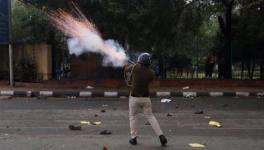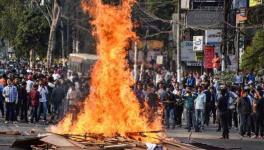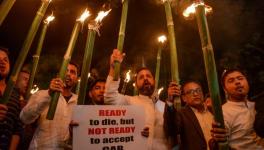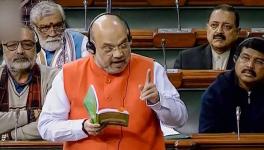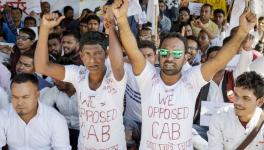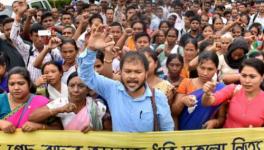CAB: What Indians Must Know About Sri Lanka’s Exclusion
The weight of the contradictions in the Citizenship Amendment Bill, 2019 are growing day by day.
On Monday, heated debates unrolled in Parliament over the Bill, which seeks to grant citizenship to Hindu, Buddhist, Christian, Parsi, Jain and Sikh refugees from India’s three Muslim-majority neighbours, Afghanistan, Bangladesh and Pakistan.
The government has been defending the iniquitous Bill by arguing that it will protect persecuted minorities who trace their “roots” to India. Yet, what has been called India’s first attempt to enshrine religion as a source of citizenship, is fraught with inconsistencies.
For instance, of late the Centre has been asked to explain why Sri Lanka’s Tamil population, who are predominantly Hindu, and who have faced persecution from the Sinhala majoritarian forces in the island nation, are excluded from the Bill.
After all, it is in Sri Lanka that the highest proportion (12.6%) of Hindus live, outside India. And it is in Sri Lanka that the highest number of Hindus have been killed after 1971—the year Bangladesh came into being. Yet, while the island nation is excluded in the Citizenship Amendment Bill, India’s eastern neighbour figures in it.
The Centre has not just glossed over the fact that Sri Lankan Tamils are about 17% of the population and they have been victims of Sinhala-Buddhists, who are about 74% of the population. (Needless to say, an overwhelming number of the Tamil people profess Hinduism as their faith.) It has also ignored Sri Lanka’s entire post-Independence history. Right from 4 February 1948, the day Sri Lanka became independent, Tamils have been denied their rights in the island nation. Further, a quarter-century long civil war raged in Sri Lanka between 1983 and 2009. It claimed between 150,000 and 200,000 Tamil (as well as Sinhala) lives, and a huge number of them were of Tamil origin.
Even in the late 1980s, hundreds of Tamils died in clashes between the Liberation Tigers of Tamil Eelam (LTTE) cadres and the Indian Peace Keeping Force (IPKF), which also suffered heavy casualties.
No doubt there were Tamil-led terrorist activities in the island nation, responsible for the 1993 assassination of Sri Lanka’s third president, Ranasinghe Premadasa, and the assassination of former Indian prime minister Rajiv Gandhi in 1991. For these reasons, and for the nature of the tactics they adopted in general, the LTTE gradually lost support, including the sympathy of the Indian government.
Over time, the Tamil population in India began to harbour suspicions towards Sri Lanka’s ethnic Tamil population, despite strong emotional and ethnic connections. At the same time, right from the 1980s, large numbers of “Ceylon Tamils” or “Jaffna Tamils” fled Sri Lanka to arrive in India, where they are now viewed with suspicion in the state and by Central governments.
The BJP is likely afraid of offending people in India’s only Tamil-majority state. Tamil Nadu is one state which has resisted the ruling party’s Hindutva outlook. The BJP has hardly any base in the state. It was routed in the Lok Sabha poll held earlier this year. Even its alliance partner, the All India Anna Dravida Munnetra Kazagham, (whose position on LTTE has differed from the Dravida Munnetra Kazagham or DMK stance) could win only one seat there. The BJP would be unlikely to risk further isolation in the south. Therefore, domestic policy has trumped the Centre’s avowed ambition to provide a safe refuge for Hindus or other non-Muslims with “roots” in India. This political compulsion is why the government would refrain from including Sri Lanka in the Citizenship Bill, while it has included Afghanistan, a country with which India does not even share a border.
This is although the actual conditions of Tamil people in Sri Lanka remains precarious. The LTTE and its supporters were brutally repressed in a 2009 military offensive by the Sri Lankan government, led by then president, Mahinda Rajapaksa. Till today, many analysts say, little has been done to change the ‘Sinhala-Only’ bent of mind of the Sri Lankan ruling class, which puts the Tamil population at a disadvantage.
After recent elections, in November 2019, hard-line leader Gotabaya Rajapaksa become president of Sri Lanka. He quickly appointed his brother, Mahinda, as prime minister. The development has raised fresh concerns about the political future of the Tamil population, as well as of the Sri Lankan Muslims, who have drifted further from Sinhalese nationalism and Sinhalese identity in recent years; and find themselves increasingly isolated in their ethnically-divided country.
If the intention of the Indian government were to assist oppressed minorities, the Sinhalese Muslims and the Hindu Tamils should surely have figured in its citizenship plans, which it is executing at risk of creating a divisive atmosphere not just in India but all South Asia.
The Bill has been criticised for this, and for leaving Muslims out of its purview, but the contradictions do not end there. In Sri Lanka for example, it is the followers of the Buddhist faith who have been radicalised and even organised into violent groups. Yet, India’s new law proposes to put Buddhists from Pakistan, Bangladesh and Afghanistan on the fast-track to citizenship. Similarly, the Bill excludes the persecuted Rohingya religious-ethnic minority of neighbouring Myanmar, whom Bangladesh has sheltered in large numbers.
The very notion that minorities of other countries, of any religion, would flock to India, is a deeply contested idea. Some analysts even argue that given India’s poor conditions, economic migrants would prefer opportunities elsewhere in South Asia and beyond.
Additionally, to rake up the condition of minorities in Afghanistan, Pakistan and Bangladesh makes for easy communal polarisation, particularly in north and central India, where the BJP has grown politically influential. Sri Lanka would not inflame sentiments in these regions as it does not help the BJP capitalise on a communal divide to serve its own political interests. This is why it has not addressed even obvious contradictions in this Bill.
To mask its communal plank, the government has pushed the specious logic that persecuted Muslims from Pakistan, Bangladesh and Afghanistan can seek asylum in other Muslim-dominated or Islamic countries, but the same holds true for Christians and Buddhists too—there are many countries with an overwhelming number of these two communities. The numbers of Christian-dominated countries are almost double than that of the Muslim.
Truth is, West Europe, the United States of America, Canada, Australia, New Zealand and most other countries do not discriminate in the name of religion when providing asylum or citizenship.
India has a long history of providing refuge to displaced persons from neighbouring countries. Sixty years back, thousands of Tibetan Buddhists and the Dalai Lama sought refuge in India. During the liberation war of Bangladesh in 1971, India provided lakhs of people from then East Pakistan refuge. However, they returned after the creation of Bangladesh.
The case of Nepal is somewhat different, as the Nepalese people can seek jobs in India, except in in central services such as the IAS, IFS and IPS. Yet, it is a fact that madhesis—that is, Hindus of Indian origin who mostly reside in the border districts of India and Nepal—have often complained about their unequal status in their new Constitution.
It is a travesty that today we oppose extending the same generosity to Rohingyas from Myanmar—while waxing on eloquent about helping persecuted minorities—only on the basis of their religious identity.
Soroor Ahmed is a freelance journalist. The views are personal.
Get the latest reports & analysis with people's perspective on Protests, movements & deep analytical videos, discussions of the current affairs in your Telegram app. Subscribe to NewsClick's Telegram channel & get Real-Time updates on stories, as they get published on our website.









